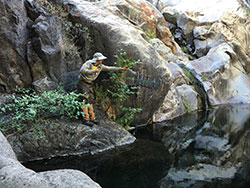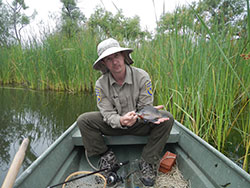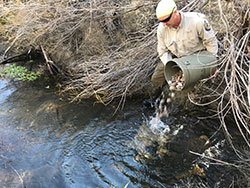Russell Barabe is a coldwater fisheries biologist based out of CDFW’s South Coast Region office in San Diego. Though he grew up San Jose, where his mom was a nurse and his dad was a facilities maintenance supervisor, Russell’s family frequently went camping and trout fishing in Shasta County. Russell was an Environmental Studies student at San Jose State University when a summer internship with the Student Conservation Association introduced him to researching fire effects at different national parks. He was hooked on the idea of working in the great outdoors as much as possible. A Master’s degree in fisheries biology at Mississippi State University put him on the path to becoming a CDFW biologist, where he’s been employed since 2009. His first duties included enforcing lake and streambed alteration regulations.

Setting a trap on the West Fork San Luis Rey River.

Collecting sample for tissue analysis, San Diego River.

Creating spawning beds for rainbow trout, Sweetwater River.
Russell Barabe is a coldwater fisheries biologist based out of CDFW’s South Coast Region office in San Diego. Though he grew up San Jose, where his mom was a nurse and his dad was a facilities maintenance supervisor, Russell’s family frequently went camping and trout fishing in Shasta County. Russell was an Environmental Studies student at San Jose State University when a summer internship with the Student Conservation Association introduced him to researching fire effects at different national parks. He was hooked on the idea of working in the great outdoors as much as possible. A Master’s degree in fisheries biology at Mississippi State University put him on the path to becoming a CDFW biologist, where he’s been employed since 2009. His first duties included enforcing lake and streambed alteration regulations.
You’re a west coast guy – what was it like completing your education at Mississippi State?
It was really cool working in the Southeast and seeing fisheries from a whole different perspective. Down there, largemouth bass are native; same with bluegill, greenfish, sunfish, and catfish. I actually studied the recovery of catfish in the coastal rivers after Hurricane Katrina. We were tagging catfish and doing mark-recapture, and then we did a full-on age analysis of flathead catfish in the Pascagoula River, which is one of the largest, last remaining undammed watersheds in the lower 48.
As a fisheries biologist based in San Diego, what does your job entail?
My primary areas are San Diego and Orange County, and I was recently assigned to the Sespe Watershed, which is all the way up in Ventura County. I do a lot of monitoring of coldwater fish populations. That includes rainbow trout, both native and non-native. I also monitor other native species like Arroyo Chub. If something goes sideways, then we come to the rescue.
What’s an example of something going sideways?
Another fish population I monitor down here is the Unarmored Threespine Stickleback. Last year we had a really large storm event come through and this population of fish is right out on the edge of the Anza Borrego Desert. This storm came through and dumped a whole bunch of rain in a short period of time and ended up washing a lot of sediment into the stream. By doing that, it made the whole stream really shallow. Later in July and August, the water started percolating into the sand and there was no habitat for the fish. Because we were going to lose these fish if we didn’t do something, we got approval to do a rescue. We went out there and grabbed as many of the fish as we could and took them to another area where we can get them to water. Fully grown, that fish might be two inches long.
San Diego is known for its ocean fishing opportunities. Do you find that people are surprised to hear there’s a coldwater fisheries biologist in the San Diego area? Can you describe the rivers and streams where you work?
San Diego is unique. I’ll talk with my colleagues up north who do work for the Heritage Wild Trout program as well. They have rivers that are 50 to 100 miles long and they sample little sections and then extrapolate the numbers out to get an idea of what’s going on. In my case, I have a section up in the mountains that still holds native trout but it’s only four miles long. I’ll decide to go camp out there for three days and snorkel everything, because I can. It’s also very difficult work because there are no trails, you're basically hiking in a stream with a full backpack and you often fall down. You’re fighting through brush and poison oak, and of course there are ticks, ants and rattlesnakes.
A snorkel survey is pretty much as it sounds, right? Face down, on your stomach, in a cold river, trying to count fish?
Correct. We just put on the mask and we have a wetsuit and we put our face in the water. With a flashlight we look under every rock to count them and try and put them into size classes. We try and do that every year so that we can track the population and say, okay, in 2017 we saw 400 and then in 2018, we only saw 30.
How do you guarantee you’re not counting the same fish over and over?
First, we always snorkel in an upstream direction. Second, if the stream is wide, we use enough snorkelers to cover the whole width. Down here, two is usually enough. Third, you only count a fish once it swims past you downstream. This way if a fish swims circles around you, you do not count it each time. If you get to the head of a pool and the fish have not swam past you, you then count those fish. This technique can be difficult if a lot of fish are present, but in Southern California, this is rarely a problem. If using more than one snorkeler, communication is important to discuss if the fish that swam between us was counted by me or the other person.
Don’t fish tend to go the other direction when you make yourself very present like that?
The surprising thing is that most fish will tolerate you when you’re snorkeling. They'll look at you a little warily but as long as you don’t try to reach out and touch them they’ll swim near you. But if you get too close, they take off and go hide under a rock.
Is there a particular project you are proud of, because you know that your work made a difference?
I would refer to some work I did on the only population of native rainbow trout left in San Diego County. There had been a report there were non-native bullhead (catfish) found in that part of the stream system. Everyone was worried about the bullhead competing with the trout, so we went out there to get genetic samples for a project to try and look at the heterozygous study of that population. (Low heterozygosity means a lack of genetic diversity. High heterozygosity means high genetic diversity.)
We were camping for the night and I said, “Why don’t we bring out a couple of traps that we have, and we’ll bait them with cat food, and we’ll throw them out just for the heck of it and maybe we’ll catch a bullhead or two.” I thought it might make a small difference. We threw out the traps and ended up catching over 30 bullhead. I thought, this is interesting, this works! When I got back to the office, I dove into the literature to see if I could find anything about anyone doing anything like that. I found a couple of projects, but no references to someone using this specific trap or using a similar technique. So we designed a study where we would use a lot of nets and cat food, and go out on trips of three days. We’d set the traps overnight because bullhead are nocturnal. On the first day, we’d set the traps in the evening. The next day, we’d walk down the stream and set our next set of traps, and camp for the night. The last day, we’d pull out the traps and then hike out. That first year we did that, we ended up removing 1,300 bullhead.
The next year, I figured we’d need to go back and do it again because the chances we’d removed everything were pretty slim. But when we went back, we trapped the entire stream and we didn’t catch a single bullhead. We went back the year after that, and we still didn’t catch anything. Removal of this invasive species is likely to benefit the native rainbow trout through a reduction in competition and possible predation.
I submitted a publication based on that bullhead work and is currently in press. It’s supposed to come out sometime this year in the North American Journal of Fisheries Management.
In a 40-hour week, how many hours are spent in those river settings vs. sitting at a desk and writing up reports?
I’m usually getting out three days a week. Because traffic can be so bad down here, travel times to a lot of these places is really tough. To get to that population of native trout I mentioned, it’s a two-hour drive. And then there’s another a two-hour hike to get to where the fish are. So it’s an eight-hour day just to get to and from where the fish are. I’ll do 12- to 16-hour days on a regular basis. It’s easy to fall behind on your emails and reports!
How would your job change if you had unlimited time and an unlimited budget?
Well, I’d love to have a helicopter to make it easier for my back country trips. Just drop me off and pick me up, that would be a great start! Every year this job gets harder. I’m 47 and I have a tech who’s 20 years younger than me. I can usually keep up with him … he might hike a little faster than me, but I’m not far behind!
CDFW Photos